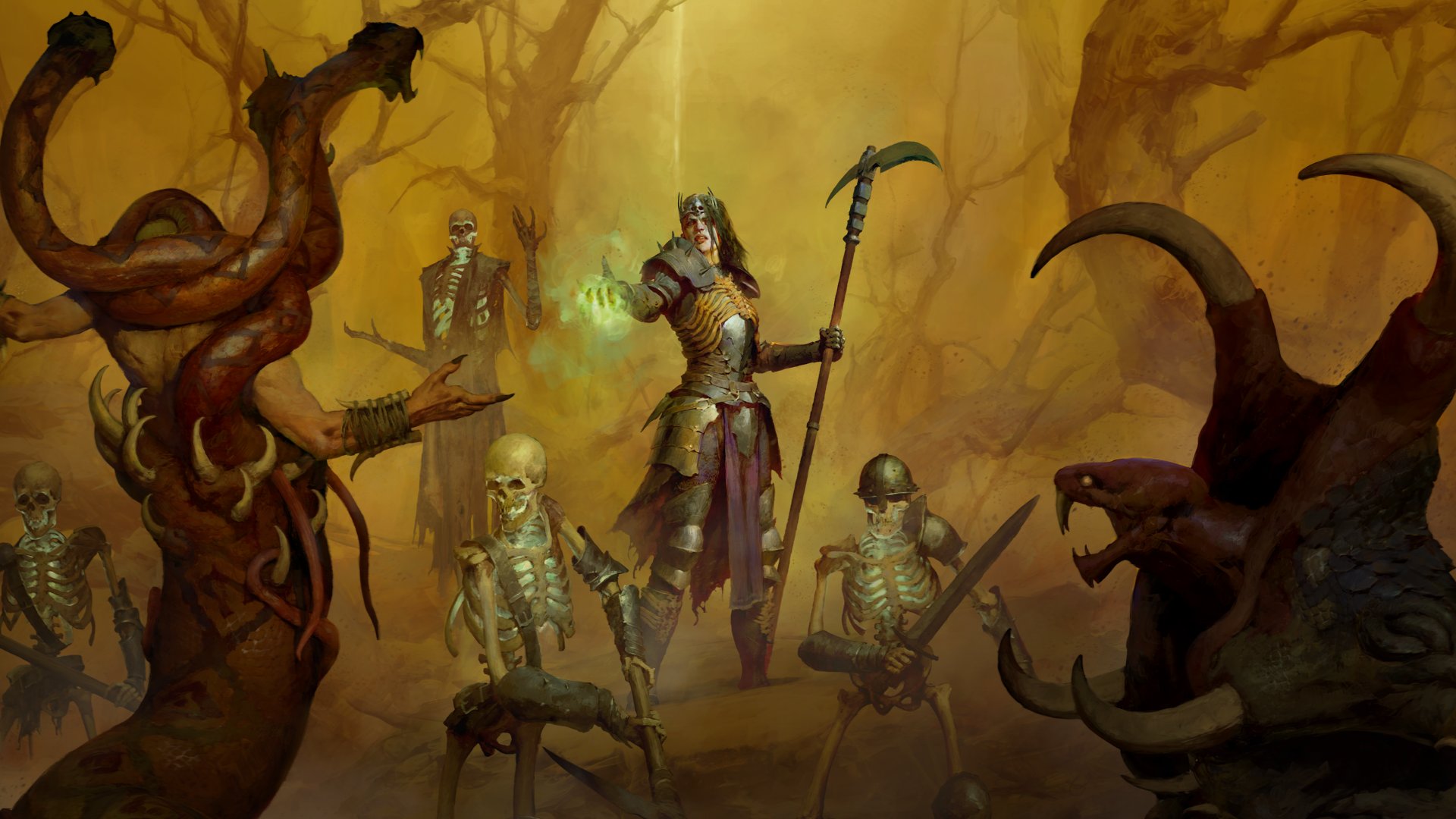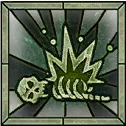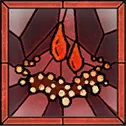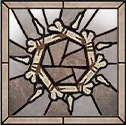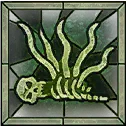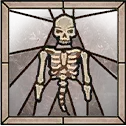This is our overview of the Necromancer, one of the five playable classes in Diablo 4.
Necromancer Builds
Whether you are just starting your adventure or grinding the endgame, we have the perfect Necromancer Build for you.
Necromancer Builds for Diablo 4Official Class Description
“Necromancers are cunning summoners that conjure vengeful hordes of the undead. Their Essence flows into three powerful bastions of Bone, Blood, or Shadow to bring low their enemies.”
Resources – Essence and Corpses
Necromancers have two different resources: Essence and Corpses.
Essence is the main resource and is comparable to the primary resource of other classes; it refills slowly over time, but can also be replenished through the use of some Basic Skills and talents. Essence is used to cast some of your most powerful skills.
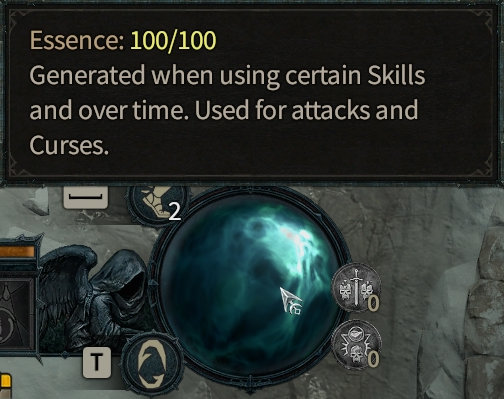
The secondary Necromancer resource is Corpses. Corpses come from fallen enemies and can be raised as minions or simply detonated.
Unique Class Mechanic
The Necromancers unique class mechanic is called The Book of the Dead. This book will unlock upon reaching Level 5 and allows Necromancers to customise their army to their liking. For example, which minions they want to summon and how they behave in combat.
There are three customisable minions: Skeletal Warriors, Skeletal Mages, and Golems.
Minions will automatically re-summon after respawning during a World Boss fight.
The first part of the Book that unlocks will be the Skeletal Warriors. Advancement through levels will then grant access to Skeletal Mages next, while Golems can only be obtained by completing a priority quest at Level 25.
Skeletal Warriors
Skeletal Warriors can be given one of three specialisation: Skirmishers, Defenders, or Reapers.
Skirmishers are standard warriors that deal 30% increased damage, but have 15% reduced Life. Defenders wear shields and have 15% increased Life. Reapers Slow attackers with wide area of effect frontal scythe attacks and have a powerful wind-up skill that deals heavy damage every 10 seconds.
Skeletal Mages
Skeletal Mages come in three varieties: Shadow Skeletal Mages, Cold Skeletal Mages, and Bone Skeletal Mages.
Cold Skeletal Mages Chill and Freeze enemies. Shadow Skeletal Mages deal additional Shadow damage. Bone Skeletal Mages launch their own bones to deal heavy Physical damage at the cost of some of their Life.
Golems
Necromancers can select one of three different types of Golems: Bone Golems, Blood Golems, and Iron Golems.
Bone Golems Taunt enemies in a wide area. Blood Golems drain Life from enemies around them. Iron Golems charge into enemies to slam the ground and Stun.
Secondary Class Mechanics
Sacrifice
Necromancers can sacrifice their minions in order to become stronger for a short period of time. For example, sacrificing a Blood Golem increases the Necromancer’s maximum Life for a short time. During that time, however, it is impossible to summon any more Golems.
Curses
Necromancers can cast Curses upon their enemies through skills like 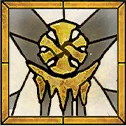 Iron Maiden and
Iron Maiden and 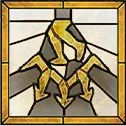 Decrepify, which inflict powerful but temporary debuffs with unique effects.
Decrepify, which inflict powerful but temporary debuffs with unique effects.
Weapons and Restrictions
Reaper’s Scythe are a unique weapon type only available to the Necromancer class. However, if you cannot get your hands on a Scythe right away, Swords, Daggers, and Wands, as well as an offhand Focus and Shield, are all available to Necromancers.
Necromancer Skills and Passives
This section provides an overview of the main skill categories for the Necromancer class.
For a more detailed and in-depth list of all Necromancer skills and talents, refer to the dedicated pages below.
Necromancer Skills Necromancer TalentsNecromancer Skills Categories
All classes have Basic, Core, and Ultimate Skills as categories. Necromancers also have Macabre, Curse, and Corpse Skills.
Basic Skills
Basic Skills are spammable skills whose primary purpose is to regenerate Essence. Basic Skills are not very powerful, but good to finish off small enemies or as a filler while waiting for more powerful skills to be available. They can also be a good source for Corpse generation.
The Basic Skills for the Necromancer are:
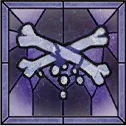 Decompose,
Decompose, 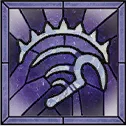 Reap,
Reap, 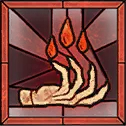 Hemorrhage, and
Hemorrhage, and 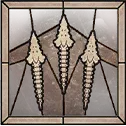 Bone Splinters.
Bone Splinters.
Core Skills
These are some of the most used Necromancer skills in any build, as they are the main source of damage. However, while Core Skills have no cooldown, their biggest drawback is their Essence cost.
The Core Skills for the Necromancer are:
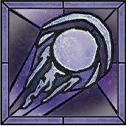 Blight,
Blight, 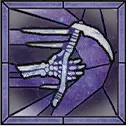 Sever,
Sever, 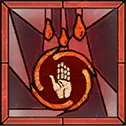 Blood Surge,
Blood Surge, 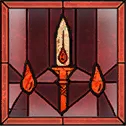 Blood Lance, and
Blood Lance, and 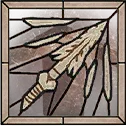 Bone Spear.
Bone Spear.
Corpse Skills
Macabre Skills help to boost the defensive capabilities of the Necromancer, as well as providing powerful offensive options.
The Macabre Skills for the Necromancer are:
Curse Skills
The Curse Skill category includes all Necromancer skills that inflict Curses or Corruption upon enemies. Curses help with dealing damage over time and increase the damage dealt to Cursed / Corrupted enemies.
The Curse Skills for the Necromancer are:
 Iron Maiden and
Iron Maiden and  Decrepify.
Decrepify.
Macabre Skills
With these skills, Necromancers can boost their own damage while summoning additional horrors to deal even more combined destruction.
The Corpse Skills for the Necromancer are:
Ultimate Skills
Ultimate Skills are powerful skills that have a long cooldown. Ultimate Skills must be built around in order to be effective, and only one can be chosen at a time.
The Ultimate Skills for the Necromancer are:
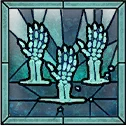 Army of the Dead,
Army of the Dead, 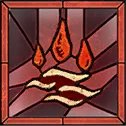 Blood Wave, and
Blood Wave, and 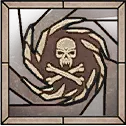 Bone Storm.
Bone Storm.
Dismount Skill
While mounted, the Necromancer class has access to a unique Dismount Skill which causes them to jump off the mount, slam the ground, and create a frontal cone of magic bones, damaging enemies in the way. Players that are struck by an enemy are automatically dismounted and are unable to use their Dismount Skill.
Necromancer Attributes
The four core attributes benefit each of the five classes in slightly different ways. Here are their effects for the Necromancer:
| Attribute | Effect 1 | Effect 2 | Effect 3 |
|---|---|---|---|
| Strength | 1 Armor per point | ||
| Intelligence* | 10% Skill Damage per 100 points | 5% All Resistances per 100 points | |
| Willpower | 10% Resource Generation per 100 points | 10% Healing Received per 100 points | 25% Overpower Damage per 100 points |
| Dexterity | 2% Critical Strike Chance per 100 points | 2.5% Dodge Chance per 100 points |
*Intelligence is considered the primary attribute for Necromancer, as it multiplies all damage.
Legendary Aspects
Legendary Aspects are for Legendary Powers that can be imprinted onto items to enhance them with strong and distinctive effects. While certain Legendary Aspects are exclusive to a single class, some are available to all classes.
For more information on Legendary Aspects and the Codex of Power, check out our guide below.
Legendary Aspect and Codex of Power GuideThe following section lists the known Legendary Aspects that are specific to the Necromancer, arranged by category. Please note that there are many more Aspects, but this list will simply cover the ones that are only for the Necromancer class.
If a category is not listed, it means that there is currently no class-specific aspect for this section of the codex.
Offensive Legendary Aspects
Offensive Legendary Aspects can only be imprinted onto the following item types: Gloves, Focus, Ring, Amulet, One-Handed Weapon, and Two-Handed Weapon.
 Blighted Aspect – Akkhan’s Grasp, Hawezar.
Blighted Aspect – Akkhan’s Grasp, Hawezar. Blood-bathed Aspect – Hoarfrost Demise, Fractured Peaks.
Blood-bathed Aspect – Hoarfrost Demise, Fractured Peaks. Blood Seeker’s Aspect – Mercy’s Reach, Fractured Peaks.
Blood Seeker’s Aspect – Mercy’s Reach, Fractured Peaks. Aspect of Bursting Bones – Path of the Blind, Dry Steppes.
Aspect of Bursting Bones – Path of the Blind, Dry Steppes. Aspect of the Damned – Uldur’s Cave, Kehjistan.
Aspect of the Damned – Uldur’s Cave, Kehjistan. Aspect of Empowering Reaper – Flooded Depths, Scosglen.
Aspect of Empowering Reaper – Flooded Depths, Scosglen. Aspect of Grasping Veins – Corrupted Grotto, Kehjistan.
Aspect of Grasping Veins – Corrupted Grotto, Kehjistan. Aspect of Reanimation – Aldurwood, Scosglen.
Aspect of Reanimation – Aldurwood, Scosglen. Sacrificial Aspect – Ruins of Eridu, Hawezar.
Sacrificial Aspect – Ruins of Eridu, Hawezar. Splintering Aspect – Guulrahn Slums, Dry Steppes.
Splintering Aspect – Guulrahn Slums, Dry Steppes. Aspect of Swelling Curse – Hive, Scosglen.
Aspect of Swelling Curse – Hive, Scosglen. Unyielding Commander’s Aspect – Faceless Shrine, Hawezar.
Unyielding Commander’s Aspect – Faceless Shrine, Hawezar. Aspect of Plunging Darkness – Rimescar Cavern, Fractured Peaks.
Aspect of Plunging Darkness – Rimescar Cavern, Fractured Peaks.- Gore Quills Aspect –
 Blood Lance will consume Blood Orbs to also conjure lances from them. Each additional Blood Lance deals 20-50% of normal damage and prioritizes targeting un-lanced enemies.
Blood Lance will consume Blood Orbs to also conjure lances from them. Each additional Blood Lance deals 20-50% of normal damage and prioritizes targeting un-lanced enemies.
Resource Legendary Aspects
Resource Legendary Aspects can only be imprinted onto the following item types: Helm, Ring, and Amulet.
 Fastblood Aspect – Iron Hold, Hawezar.
Fastblood Aspect – Iron Hold, Hawezar. Flesh-Rending Aspect – Nostrava Deepwood, Fractured Peaks.
Flesh-Rending Aspect – Nostrava Deepwood, Fractured Peaks. Hulking Aspect – Sepulcher of the Forsworn, Kehjistan.
Hulking Aspect – Sepulcher of the Forsworn, Kehjistan. Aspect of Potent Blood – Betrayer’s Row, Dry Steppes.
Aspect of Potent Blood – Betrayer’s Row, Dry Steppes. Requiem Aspect – Vault of the Forsaken, Scosglen.
Requiem Aspect – Vault of the Forsaken, Scosglen. Aspect of Torment – Black Asylum, Fractued Peaks.
Aspect of Torment – Black Asylum, Fractued Peaks.
Utility Legendary Aspects
Utility Legendary Aspects can only be imprinted onto the following item types: Helm, Chest Armor, Boots, Gloves, and Amulet.
 Torturous Aspect – Deserted Underpass, Kehjistan.
Torturous Aspect – Deserted Underpass, Kehjistan.
Unique Items
Unique items are the highest tier of items that can be found in Diablo 4. They are very rare and therefore harder to get, but will most likely be part of the best-in-slot gear for each class.
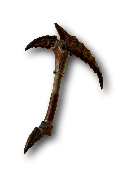 Black River
Black River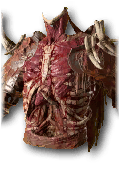 Blood Artisan’s Cuirass
Blood Artisan’s Cuirass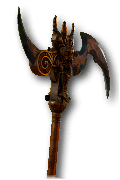 Bloodless Scream
Bloodless Scream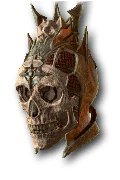 Deathless Visage
Deathless Visage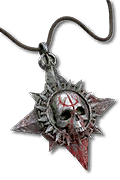 Deathspeaker’s Pendant
Deathspeaker’s Pendant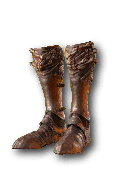 Greaves of the Empty Tomb
Greaves of the Empty Tomb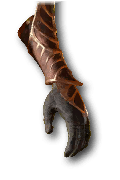 Howl from Below
Howl from Below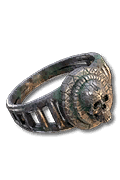 Ring of Mendeln
Ring of Mendeln
Lidless Wall (New in Season 1)
- Shield
- Unique Effect: Lucky Hit: While you have an active
 Bone Storm, hitting an unaffected enemy has a x% chance to spawn an additional storm at their location. Each of your active Sacrifice bonuses increases the chance by 25% and the total additional Bone Storms you can have by +1.
Bone Storm, hitting an unaffected enemy has a x% chance to spawn an additional storm at their location. Each of your active Sacrifice bonuses increases the chance by 25% and the total additional Bone Storms you can have by +1. - Stats: 20% Block Chance
- x% Blocked Damage Reduction
- + x% Main Hand Weapon Damage
- + {#} Thorns
- + x% Attack Speed
- + x% Damage to Distant Enemies
- Lucky Hit: Up to a 5% Chance to Restore +x% Primary Resource
- + {#} Maximum Essence
